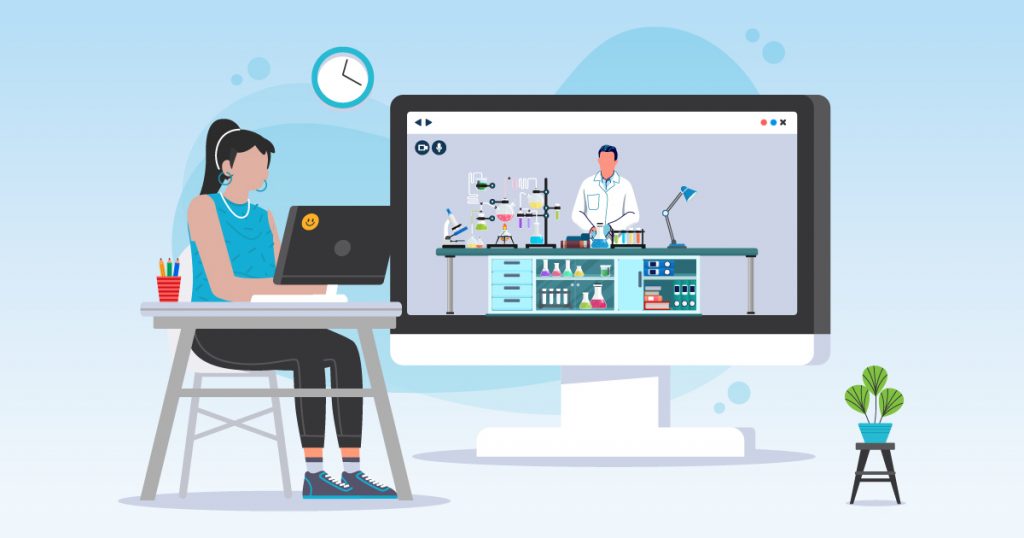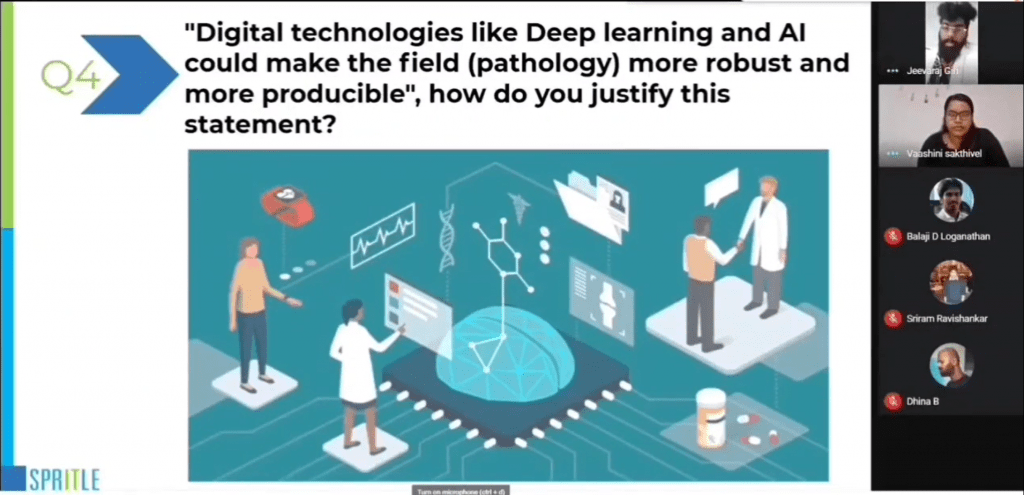
Hey, y’all. Doing great? We do too. Thanks! Hope you all enjoyed reading the last two blogs about Digital Healthcare Solutions and gained the knowledge that we are trying to give. And yes, you have guessed it right! This blog is also about the webinar that we conducted recently titled ‘Pathologist & Digital Healthcare’.
An interview with Dr. Jeevaraj Giridharan, an Associate Professor and a Consultant Pathologist @ SRM Medical College hospital & Research Centre, Trichy.
Dr. Jeeva is an enthusiastic person and he made great efforts to take us on a tour around his Pathology Laboratory & shows the instruments used there. He explains about their uses and functionality too.
I get exhausted 😩 every time just by thinking about in which way should I write a new blog as all seem to have the same pattern of writing. So, I’ll summarize & talk about the important points on what I understood from the webinar.
Please do watch the YouTube video and stuff your heads because Dr. Jeeva has given a ton of info throughout the webinar. For me, it was fascinating to listen to his works and the point of view he has towards Digital Healthcare.

Let us begin,
Pathology & Pathologist:
Pathology firstly is related to the study of diseases. Any deviation from the normal identified in the sample tissues (termed as Abnormality) is called as disease, which is dealt with in pathology.
So, pathology as everyone knows is diagnosing diseases through examining the human tissue samples & body fluids and the one who does this process is called a Pathologist. What will be their sole roles and responsibilities in the field?
Roles & Responsibilities:
To list out the work done by pathologists, they would be:
- Firstly, they will be receiving samples of patients from clinicians and other specialists like cardiologists, orthopedists, surgeons, pediatrist, gynecologists, etc.
- Next would be, processing the collected samples using various techniques.
- Identifying the abnormalities present in the samples will be the next role of the pathologist.
- After identification, documenting the results of the tests in the database for future use or long-term storage will be the next step done.
- Finally, it would be reporting the documents to the respective clinicians and the patients (has to be properly documented and reported to the patient at the proper time)
Digital Technologies encounter:
The ‘Microscope’ personified as the ‘Godfather of Pathology’ is used for the identification of abnormalities, which will be the first step in screening the collected samples.
As mentioned earlier, the microscope is the instrument used for the first screening process of the samples. Apart from that, there are Automation Machines and Analyzers to do diagnosis, which I will be explaining later.
To avoid the artifacts that arise during the collection of the samples, a new system was implemented. So, not too recently but like four to five years back, the Barcode system for the samples was adopted.
In every sample collected from each individual, there will be a specific barcode, that helped reduce mistakes or technical errors that are bound to occur. Now, all the laboratories are encouraged to use this barcode system for the samples that are collected for diagnosis.
Automation Machine for counting the blood cells in the collected blood sample. The blood cells consist of RBCs and WBCs (this is very basic as everyone would have studied about it in their childhood).
The blood which is collected must be stored and screened before using it for any analysis or transfusion. The first and foremost thing to do with the blood sample is to maintain it at the correct temperature.
It is because the difference in temperature inside and outside the body is large. It needs to be kept in the proper state for transfusion or other purposes.
So, we use deep freezers with temperature monitors to maintain the temperature and avoid the blood from clotting.
“Digital technologies like Deep Learning and Artificial Intelligence can make your field ‘Pathology’ more robust & more producible”
Ahh, this is my favorite part of the entire webinar. Want to know why? Continue reading…🧐
Gene mutations or Genetic mutations can be one of the reasons for the discovery of many pathologies in humans including cancer & other diseases. A system incorporated with AI capable of detecting such mutations in the body even before it has developed will be of great use.
Let’s say a patient, he or she has the habit of smoking. Everyone knows what follows, yes! Might lead to cancer. With Artificial Intelligence we can train the system in a way to detect various parameters:
The type of mutation, which part or group of cells are going to be mutated etc. even before the patient comes in with any kind of symptoms for a pathology.
This helps in early diagnosis or early warning for the patient with, ‘You are this much percentage prone to developing some symptoms soon due to so and so reasons. Please visit a specialist near you and get a consultation’ kind of alert.
In today’s situation 1.) Detection, followed by 2.) Telemedicine and then 3.) Detailed Diagnosis tailed with 4.) Treatment, 5.) Recovery and 6.) After the recovery phase of the patient.
If the detection part can be done as early as possible, it can greatly reduce the time of diagnosis & treatment. This obviously increases the recovery time and the patient can be given more care after the recovery period.
I’ll make it more clear,
The pathologists presently identify the pathology that has already started to cause a change inside the patient’s body and suggest them to get treated accordingly.
Taking Artificial Intelligence in the game, detecting the mutation that is gonna happen inside the body even before the outburst might be possible.
So, with this kind of system, we will be able to treat the patient at the earliest and save them from landing into the irreversible stages of the illness.
Another favorite part I would say is, About Digital Biomarkers:
To be exact about Digital Biomarkers, it can be said as the data that are collected from various digital devices like smart wearables and that data can be used for analytics.
They are very much used in recent times when digitization started in the Healthcare domain. Examples for digital biomarkers:
- Smart wearables like wrist bands, smartwatches, etc.
- Glucometers
- Blood Pressure analyzers
An important & very helpful biomarker that has replaced the normal Endoscopy method of abdomen imaging & analysis, the Digital Capsules or Digital Pills.
In a normal Endoscopy, a long tube with a camera & a light at one end will be placed inside the mouth of the patient & the images of the entire digestive tract will be viewed on a monitor. This might be a painful procedure for many patients.
Digital pills or capsules greatly replace them. They have a micro camera inside them which will be swallowed by the patient. The capsule will dissolve and the camera inside will have the view of the entire stomach and produce a report.
This has greatly reduced the pain and the uncomfortableness in doing a normal endoscopy. The patient is free from the device and doesn’t have any connection to it. And one main point is that this capsule does not have any effect on the patient’s body.
That was a lot of info about digital technologies encounter right? I too felt the same.
Let us all meet at the next blog with more information about Digital Healthcare technologies, real-time problems, and the solutions that doctors require which can be done only by people like us. Don’t you agree with me 😉?
Thank you!
